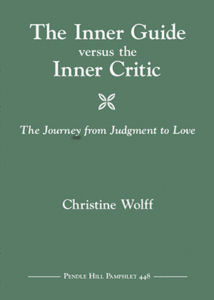The Inner Guide versus the Inner Critic: The Journey from Judgment to Love
Reviewed by Marty Grundy
November 1, 2018
 By Christine Wolff. Pendle Hill Pamphlets (number 448), 2017. 34 pages. $7/pamphlet.
By Christine Wolff. Pendle Hill Pamphlets (number 448), 2017. 34 pages. $7/pamphlet.
Buy from QuakerBooks
Christine Wolff, a psychologist using the Diamond Approach, writes of the interaction of what she calls the “Inner Critic” with what Friends call the “Inner Guide.” The Inner Critic or Judge is the inner voice that criticizes and tells us we have failed, are not good enough, or are guilty. It raises fears that—if we were to speak or act boldly—we would not be loved or valued. The Inner Critic was birthed by the need of the young child to obey their parents or caregivers. But this mechanism is not helpful for spiritually maturing adults because it acts as a gatekeeper hindering our full experiencing or even awareness of the range of our emotions. We need to feel all of our emotions, but we do not need to act upon them.
Wolff helpfully differentiates among the Inner Critic (which is harsh in its dichotomous judgments), the Conscience (which is much more nuanced and develops, from personal observation and experience, a sense of fairness and empathy), and the Inner Guide (that offers truth known intuitively, often with an immediate sense of Divine Presence). One way to differentiate them is to pay attention to one’s emotions. The Inner Critic tries to suppress “negative” emotions such as anger, fear, jealousy, sadness, guilt, or whatever is deemed “unquakerly.” But if we do not acknowledge them, they will come out later in unexpected ways. The author wisely reminds us, “We do not get to choose what we feel, although we can choose how to handle the feelings once we have acknowledged them.”
That busy Inner Critic often uses the old technique of projection to try to make ourselves feel better by projecting our own negative feelings on others. Judgment supplants compassion. Wolff points out: “We are not bad people because we are not perfect. Once we learn to accept ourselves as flawed, it becomes easier to accept our mistakes without criticizing ourselves for them.” Owning our own self-judgment and mistakes enables us to more easily accept others for whom they are.
The reasons we so strongly cling to the Inner Critic rather than trusting the Inner Guide include its familiarity and the sense of security and certainty it provides. It is rigid and stern. It enjoys judging others, often disguising our efforts to straighten someone else out as doing it for their own good. But the Inner Critic is very threatened by love: the sure, calm, all-encompassing love that is the matrix in which the Inner Guide lives and works.
This is a useful pamphlet that provides helpful suggestions for getting past the blocks to discerning and following the still, small voice of the Inner Guide. It comes with three exercises and brief suggestions for how to use the pamphlet in adult First-day school. A faith community could be enriched and strengthened by taking on the lessons offered here.



Comments on Friendsjournal.org may be used in the Forum of the print magazine and may be edited for length and clarity.